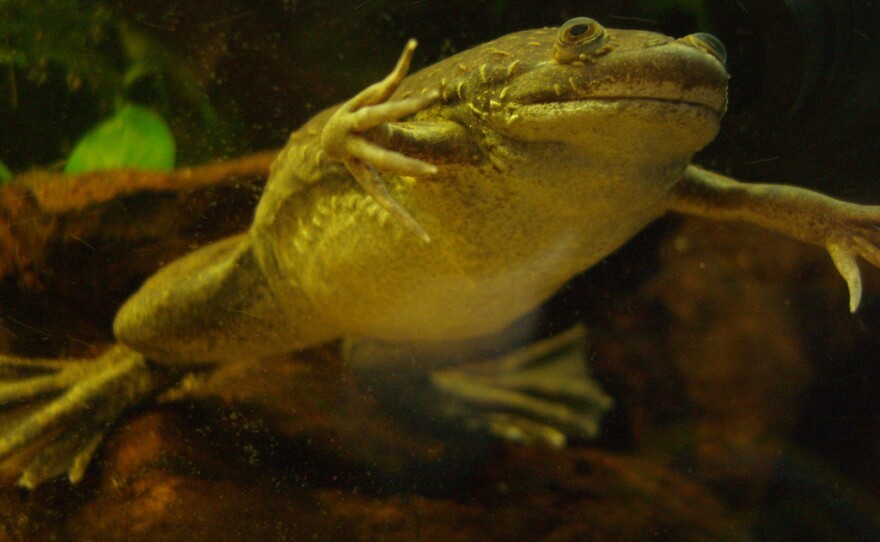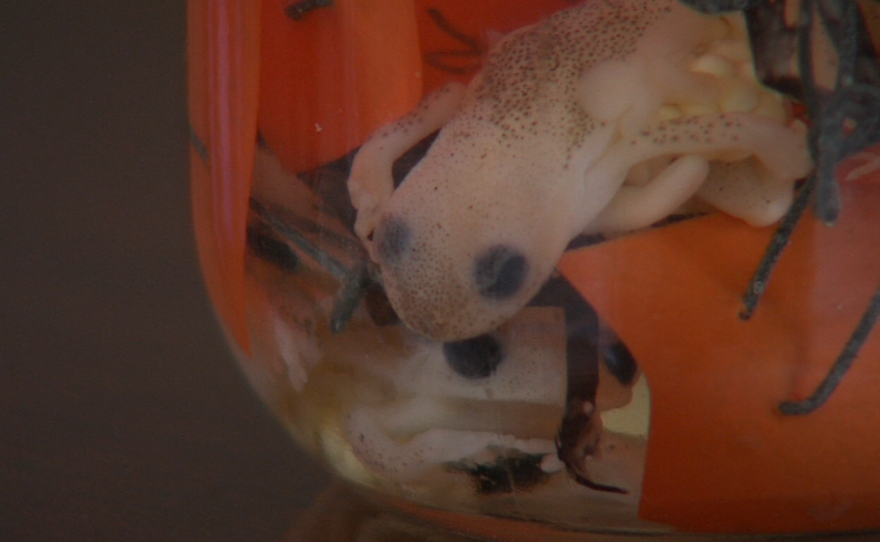Dr. Allan Pessier often finds himself in San Diego pet stores, peering into the frog tanks. But he's not shopping for pet frogs. He's looking for fungus.
"I've bought one or two of them on occasion because I've noticed they're sick," he said. "I've tested them. They're dying of this infection."
The chytrid fungus is what they're dying from. As the San Diego Zoo's resident frog disease expert, Pessier knows all about this deadly infection. He helps detect it in the wild and in zoo frogs. He's worried that the fungus could make most of California's frogs simply disappear.
"Some people have compared it to extinction events of the dinosaurs on scale, just in terms of what's being lost," said Pessier. "And people don't realize it."
This week, a team of researchers including Stanford's Sherril Green published the first evidence that the fungus is being carried by African clawed frogs throughout California. They found two infected frogs in San Diego. Green said they're thriving here.
"They like standing, still water," she said. "The weather is perfect; it's a nice temperate climate."
Scientists first noticed that the fungus was affecting frogs in the 1990s. Ever since, they've seen a catastrophic decline in amphibian populations around the world.

"Some species have been wiped out," said Green. Species like Australia's infamous gastric-brooding frog, which gave birth through its mouth. Other species, like California's now endangered Sierra Nevada yellow-legged frog, are just barely hanging in there. "We're facing a period of amphibian decline that is fairly unprecedented."
Two hundred species have already become extinct because of the chytrid fungus.
"Once the fungus reaches some of those populations of frogs, you can have almost complete loss of frogs at a a particular site within a matter of weeks," said Pessier.
Finding this fungus in African clawed frogs is particularly scary, because they're not affected by the disease. That means they're really good at spreading it to lots of other frogs, who slowly suffocate to death as the fungus clogs their skin.
"If you were infected with a fungus like athlete's foot or something like that, it's annoying to us but it won't kill us," said Pessier. "If you're a frog and you're physiologically dependent on absorbing water through your skin, all of a sudden a minor skin infection becomes really important."
So why is this happening? Why here? Why now?
In part, it's because African clawed frogs were never supposed to be in places like California in the first place. As their name implies, they're indigenous to Africa, where they probably lived in harmony with the chytrid fungus for centuries. But in the early 1900s, these frogs were imported all over the world for a peculiar reason.
"It was really widely used as a pregnancy test," says Dr. Pessier.
That's right — pregnancy tests. A few generations ago, if you were a woman hoping to conceive, you would have your urine injected into an African clawed frog. If the frog produced eggs, congratulations, you were pregnant.

With the advent of frog-less pregnancy tests in the 1960s, doctors did away with the procedure. But the frogs stayed, making themselves right at home and pushing out the natives.
"They're very indiscriminate eaters," said Pessier, putting it mildly. These voracious invaders will eat any amphibian in their path. They even cannibalize their own species.
Humans don't get sick from the chytrid fungus. In fact, African clawed frogs are farmed for food in certain parts of the world. But if these frogs do end up spreading the chytrid fungus far and wide, they could throw ecosystems out of whack. Without frogs to eat them, insects would swarm. And without frogs to eat, birds would starve.
Is there anything we can do to stop this fungus from wiping out amphibians?
Some, like retired state warden Miles Young, have proposed an all-out elimination of the unwelcome frogs. He wanted to go commando on the invasive species by draining the ponds in San Francisco's Golden Gate Park, effectively killing off these water-dwelling amphibians.
But such an approach isn't feasible, says Green, who points out that we'd never be able to find and kill every African clawed frog in California, let alone North America. "They're here to stay," she says. Instead, researchers hope to find out why a select few frogs seem to be immune in order to bolster resistance in other frogs.
Pessier said that one drastic, yet highly effective solution is to bring the frogs into captivity and breed them in a fungus-free environment. "It may be the only hope to save those species at this point," he said.
At home, people can help abate the problem by not buying invasive frogs as pets. Pessier said, "I don't want to shut down the pet trade, but I also don't want to walk into the local pet trade and find infected frogs."
Whatever you do, don't release your pet frogs into the wild.






